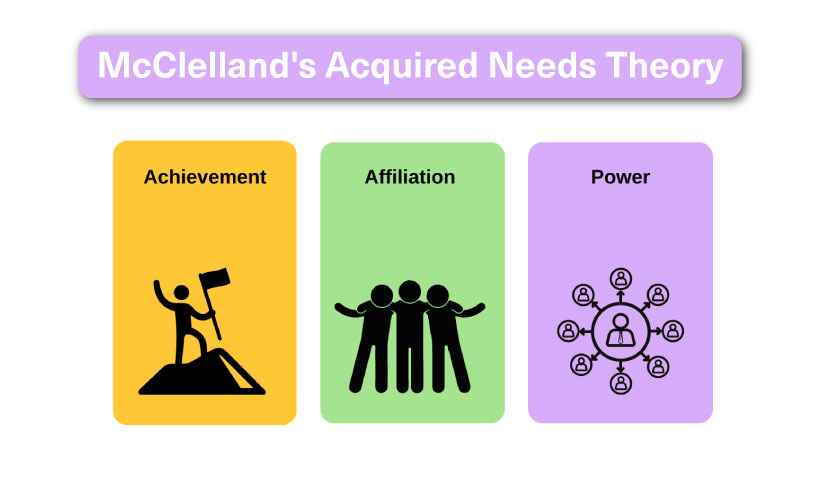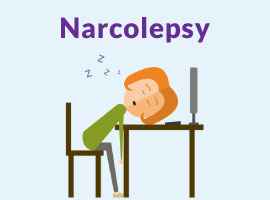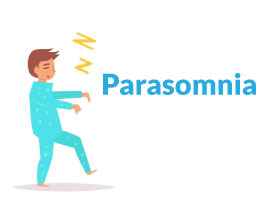McClelland's acquired needs theory is a motivational theory that proposes that individuals have three main needs that drive their behavior: achievement, affiliation, and power. These needs are not innate, but are learned through experiences in childhood and adulthood.
• Achievement need is the desire to succeed, to master challenges, and to set and achieve difficult goals. People with a high need for achievement typically enjoy taking on challenges, setting ambitious goals, and working hard to achieve them. They are also motivated by feedback and by the feeling of accomplishment that comes from success.
• Affiliation need is the desire to be liked and accepted by others. People with a high need for affiliation typically enjoy working with others, forming close relationships, and being part of a group. They are also motivated by social approval and by the feeling of belonging that comes from being accepted by others.
• Power need is the desire to control others, to influence others, and to be in charge. People with a high need for power typically enjoy being in positions of authority, making decisions, and having their influence felt by others. They are also motivated by the feeling of power and control that comes from being in charge.

McClelland's theory suggests that the strength of these three needs can vary from person to person, and that the dominant need for each individual will shape their behavior and motivation. For example, a person with a high need for achievement is likely to be more motivated by challenging tasks and by the feeling of accomplishment that comes from success. A person with a high need for affiliation is likely to be more motivated by social approval and by the feeling of belonging that comes from being part of a group. And a person with a high need for power is likely to be more motivated by the feeling of power and control that comes from being in charge.
McClelland's acquired needs theory has been used to explain a wide range of human behavior, including work motivation, leadership style, and interpersonal relationships. It is a valuable tool for understanding what motivates people and for designing effective motivational strategies.
Criticism of McClelland's acquired needs theory
Sure, here are some of the criticisms of McClelland's acquired needs theory:
• The theory is difficult to measure. The Thematic Apperception Test (TAT), which is used to measure the three needs, is a projective test that is open to interpretation. This can make it difficult to get accurate results.
• The theory is not universally accepted. Some psychologists believe that the three needs are not the only factors that motivate human behavior. They argue that other factors, such as personality traits and cultural values, also play a role.
• The theory is static. McClelland's theory suggests that the three needs are relatively stable throughout a person's life. However, some psychologists believe that these needs can change over time, depending on a person's experiences and circumstances.
Despite these criticisms, McClelland's acquired needs theory remains a valuable tool for understanding human motivation. The theory has been used to explain a wide range of human behavior, and it can be a helpful guide for designing effective motivational strategies.
Here are some additional criticisms of McClelland's theory:
• The theory does not account for the role of basic needs. McClelland's theory focuses on three acquired needs, but it does not account for the role of basic needs, such as the need for food, shelter, and safety. These basic needs are essential for survival, and they can have a significant impact on motivation.
• The theory is culture-bound. McClelland's theory was developed in the United States, and it may not be applicable to other cultures. For example, the need for power may be more important in some cultures than in others.
• The theory is too simplistic. McClelland's theory suggests that there are only three basic needs, but other psychologists believe that there are many more. This could make the theory less accurate.
Overall, McClelland's acquired needs theory is a valuable tool for understanding human motivation. However, it is important to be aware of its limitations.
Acquired needs theory in the workplace
McClelland's acquired needs theory can be applied to the workplace in a number of ways. For example, it can be used to:
• Understand the motivation of employees:
By understanding the different needs that motivate employees, managers can create a more motivating work environment. For example, employees with a high need for achievement may be motivated by challenging tasks and clear goals. Employees with a high need for affiliation may be motivated by opportunities to work with others and build relationships. And employees with a high need for power may be motivated by opportunities to influence others and make decisions.
• Design effective motivational strategies:
Once managers understand the needs of their employees, they can design effective motivational strategies. For example, employees with a high need for achievement may be motivated by merit-based rewards, such as bonuses or promotions. Employees with a high need for affiliation may be motivated by opportunities to socialize with their colleagues and participate in team-building activities. And employees with a high need for power may be motivated by opportunities to lead projects or make decisions.
• Select and develop employees:
McClelland's theory can also be used to select and develop employees. For example, if a company is looking for employees who are motivated by challenging tasks, they may want to select candidates who have a high need for achievement. And if a company is looking for employees who are motivated by opportunities to influence others, they may want to select candidates who have a high need for power.
Overall, McClelland's acquired needs theory can be a valuable tool for understanding and motivating employees in the workplace. By understanding the different needs that motivate employees, managers can create a more motivating work environment and select and develop employees who are well-suited to their roles.
Here are some specific examples of how McClelland's acquired needs theory can be applied to the workplace:
• A manager with a high need for achievement may be motivated by setting ambitious goals and working hard to achieve them. They may also be motivated by feedback and by the feeling of accomplishment that comes from success.
• A manager with a high need for affiliation may be motivated by opportunities to work with others, form close relationships, and be part of a team. They may also be motivated by social approval and by the feeling of belonging that comes from being accepted by others.
• A manager with a high need for power may be motivated by being in positions of authority, making decisions, and having their influence felt by others. They may also be motivated by the feeling of power and control that comes from being in charge.
By understanding the different needs that motivate managers, organizations can create a more motivating work environment for them. For example, organizations can provide managers with challenging tasks, opportunities for feedback, and opportunities to work with others. They can also provide managers with opportunities to develop their leadership skills and to make decisions that have a significant impact on the organization.
The McClelland theory of needs test is a psychological test that is used to measure the three needs identified by David McClelland: achievement, affiliation, and power. The test is a projective test, which means that it presents the test-taker with ambiguous stimuli and asks them to create stories about them. The stories that the test-taker creates are then analyzed by a psychologist to determine their levels of achievement, affiliation, and power.
The McClelland theory of needs test is a valid and reliable measure of these three needs. However, it is important to note that the test is not without its limitations. For example, the test can be time-consuming to administer and score, and it is not always easy to interpret the results.
If you are interested in taking the McClelland theory of needs test, you should contact a psychologist who is trained in administering and scoring the test.
Here are some of the advantages of the McClelland theory of needs test:
• It is a valid and reliable measure of the three needs.
• It can be used to assess the needs of individuals in a variety of settings, including the workplace, school, and therapy.
• The test is relatively easy to administer and score.
Here are some of the disadvantages of the McClelland theory of needs test:
• It is a projective test, which means that the results can be open to interpretation.
• The test can be time-consuming to administer and score.
• The test is not always available, as it requires specialized training to administer and score.
Overall, the McClelland theory of needs test is a valuable tool for assessing the needs of individuals. However, it is important to be aware of its limitations before using it.
Sure, here are some examples of McClelland's acquired needs theory:
• Achievement need: A person with a high need for achievement might set ambitious goals for themselves, work hard to achieve them, and be motivated by feedback and the feeling of accomplishment. For example, a person with a high need for achievement might be a scientist who sets out to make a major discovery, or a businessperson who sets out to start their own company.
• Affiliation need: A person with a high need for affiliation might be motivated by social approval and the feeling of belonging. For example, a person with a high need for affiliation might be a social worker who enjoys working with people, or a teacher who enjoys building relationships with their students.
• Power need: A person with a high need for power might be motivated by the feeling of power and control. For example, a person with a high need for power might be a politician who enjoys being in charge, or a CEO who enjoys making decisions that have a significant impact on their company.
Here are some specific examples of how McClelland's acquired needs theory can be applied to different professions:
• Achievement need: In the workplace, people with a high need for achievement might be motivated by challenging tasks, clear goals, and feedback. They might be drawn to careers in research, sales, or management.
• Affiliation need: In the workplace, people with a high need for affiliation might be motivated by opportunities to work with others, build relationships, and feel like they belong. They might be drawn to careers in customer service, human resources, or teaching.
• Power need: In the workplace, people with a high need for power might be motivated by opportunities to influence others, make decisions, and be in charge. They might be drawn to careers in politics, law, or business.
It is important to note that these are just a few examples of how McClelland's acquired needs theory can be applied to different professions. The specific needs that motivate individuals will vary depending on their personality, experiences, and values.








